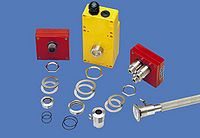Spark Detectors
Spark Detectors are preventive measure. It detects glowing particles in a closed transport system so they can be extinguished or otherwise removed before they can start an explosion.
Typical Design
An effective Spark detector must monitor all potential paths of a spark or ember through all branches of ducts and once a spark or ember is detected, it must establish a curtain of water through which the spark must pass. Each main duct system is considered a protection zone. If your dust collector has a single main duct, then only one zone is required.
The air in the ducts is travelling at a very great rate of speed and therefore carries a spark or ember very rapidly. Air transport speeds of 6000 ft/min. are not uncommon which means a spark can be carried 100 feet in one second. Detecting the spark, turning on the water and establishing a spray curtain across the entire duct can take as much .288 seconds or .0048 minutes. If the spark is travelling a 100 feet per second, we will therefore require the detector to be placed at least 28.8 feet ahead of the water spray nozzle since that is how far the spark will travel in .288 seconds. If there is insufficient length available on the main duct, detectors can be placed on the branch lines or the main duct must be extended.
Typical Location
Detectors react very quickly to sparks and embers and therefore, the water spray pattern is established very quickly. The most significant delay in entire system is the reaction time of the water solenoid valve and the time it takes for the water spray to provide a curtain across the entire duct. The time it takes for the solenoid valve to open introduces the largest delay. There are a number of factors which effect the solenoid such as water pressure and mechanical variations in the valve itself. Since these factors are variable, we must allow the maximum time in our calculations to ensure the curtain of water is fully developed before the spark arrives.
The various maximum delay factors involved are:
- detector response time: 60 usec
- micro-processor sampling cycle: 20 msec
- assembly opening time: 200 msec
- water spray traverse time of the duct: 68 msec
Video

